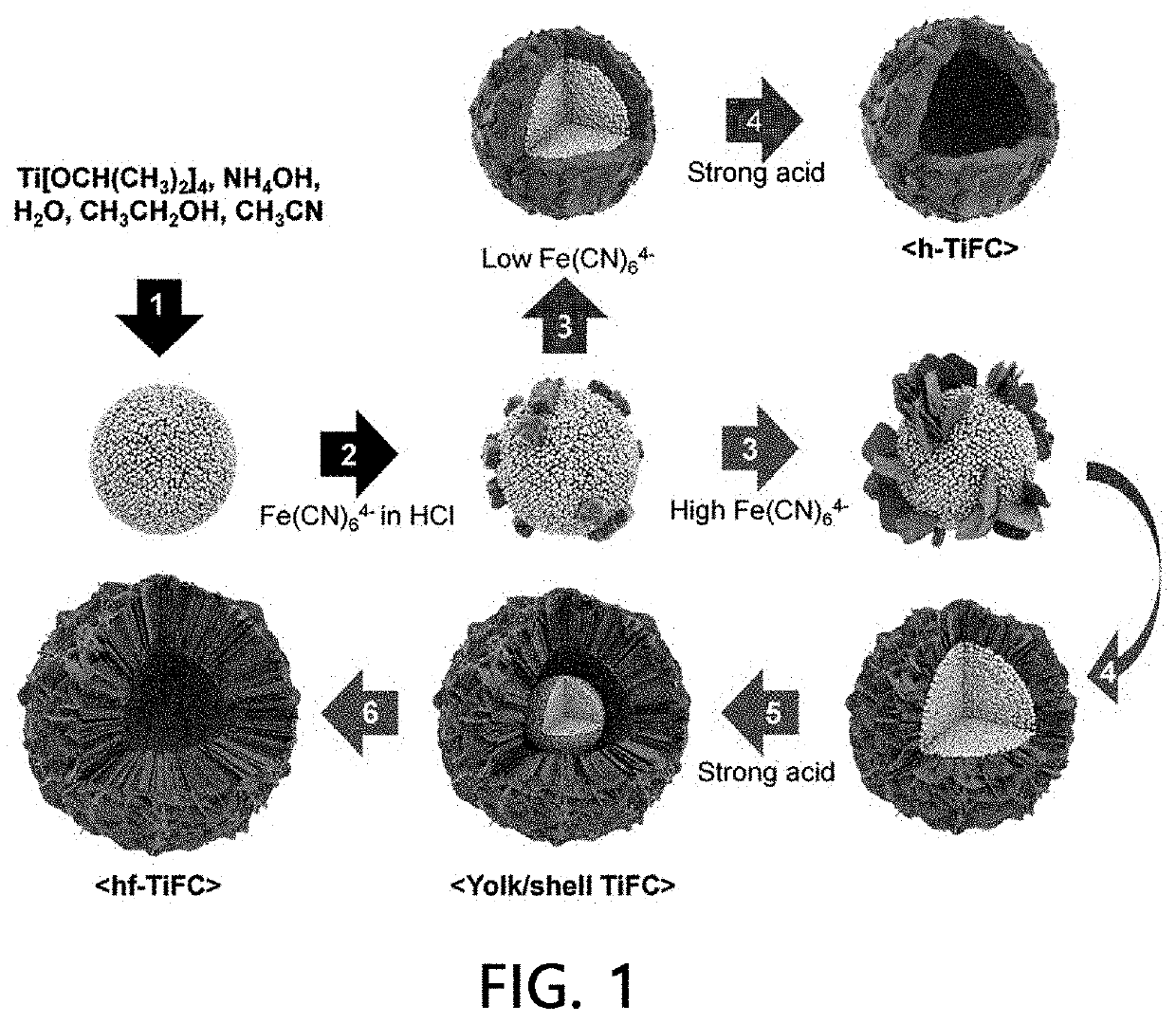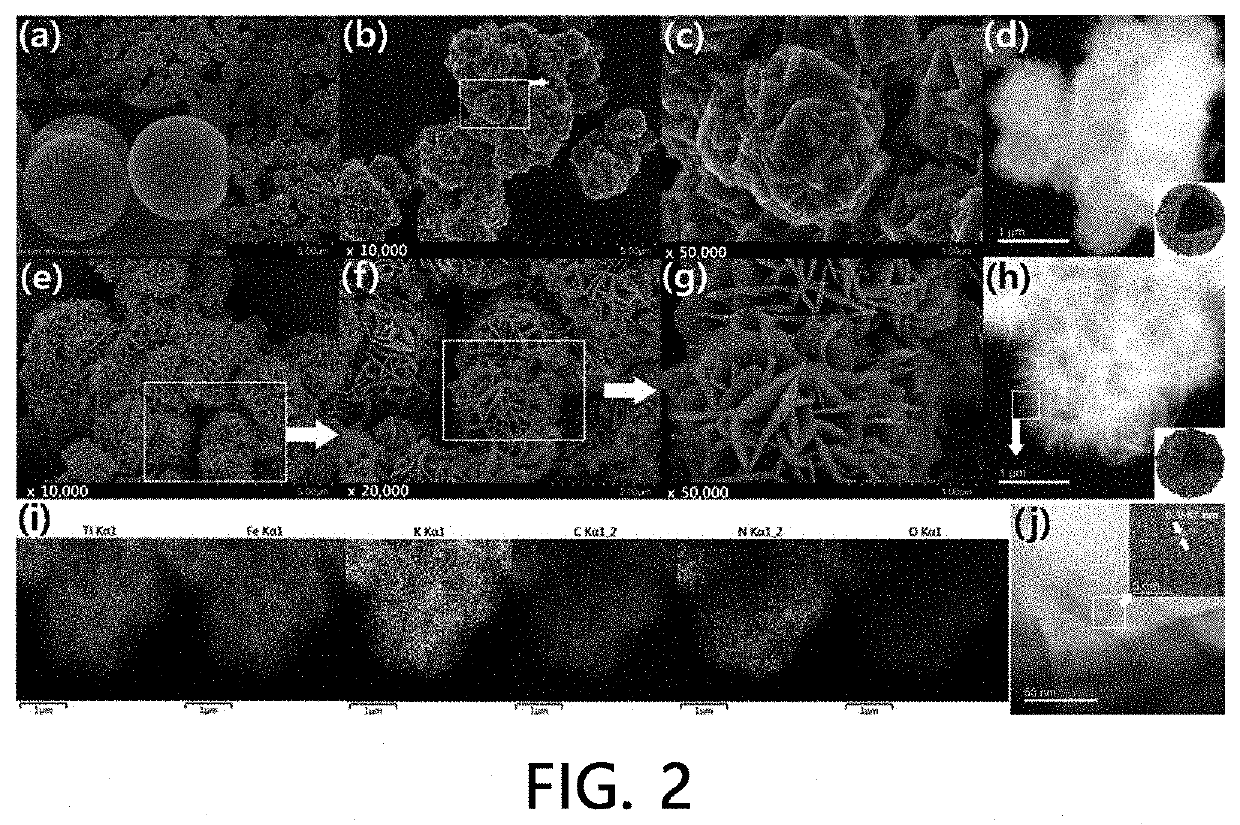Radionuclide adsorbent, method of preparing the same and method of removing radionuclide using the same
- Summary
- Abstract
- Description
- Claims
- Application Information
AI Technical Summary
Benefits of technology
Problems solved by technology
Method used
Image
Examples
example 1
on of Radionuclide Adsorbent
[0096]Synthesis of Hydrated TiO2 Particles (Average Diameter: 500 nm)
[0097]A solution (250 mL) in which a NH4OH solution (28%, 0.42 mL), H2O (0.91 mL), ethanol (150 mL) and acetonitrile (100 mL) were mixed was prepared, and titanium isopropoxide represented by Formula 1 was added thereto, thereby preparing a milky solution. The resulting solution was further stirred for 6 hours, and hydrated TiO2 particles were recovered using a centrifuge and then washed with water and ethanol several times, followed by drying in a vacuum oven at 60° C.
[0098]Preparation of Radionuclide Adsorbent (h-TiFC or Hf—TiFC)
[0099]100 mg of hydrated TiO2 particles were dispersed in a 1.5 M HCl solution and rapidly mixed with a 1.5 M HCl solution containing potassium ferrocyanide (FC, K4Fe(CN)6.3H2O), thereby preparing a dispersion. Here, the concentration of the hydrated TiO2 particles in the dispersion for preparing hollow titanium ferrocyanide (h-TiFC) or hollow flower-like titan...
example 2
on of Bead-Type Radionuclide Adsorbent
[0139]Preparation of Bead-Type Radionuclide Adsorbent to which Hf—TiFC was Applied
[0140]First, a 2% (w / v) sodium alginate solution was prepared by solubilizing sodium alginate in deionized water. Here, the resulting solution is a yellow viscous solution. Meanwhile, to apply an adsorbent to a sodium alginate solution, provided that a weight of the 2% (w / v) sodium alginate solution was 1, the weight of added NaX (Na86(AlO2)86(SiO2)106.xH2O, 2 μm, Sigma-Aldrich) was adjusted to 0.5 to 2, and the weight of the added hf-TiFC was adjusted to 0.5 to 2, thereby preparing a sodium alginate composition. The resulting composition was sufficiently mixed, and then dropped into a CaCl2 solution drop by drop using a pipette. As a result, alginate gel beads are not formed in 0.01 M and 0.05 M CaCl2 solutions, which is because a Ca-alginate gel is not sufficiently crosslinked due to a low concentration of Ca ions. Accordingly, to sufficiently form a Ca-alginate ...
example 3
on of Magnetic Radionuclide Adsorbent
[0154]Fe3O4 nanoparticles (average diameter: 100 nm) were prepared, and a 10 nm-thick SiO2 layer was then coated thereon. A 10 to 200 nm-thick TiO2 layer was coated on the surface of the SiO2 layer-coated Fe3O4 nanoparticles. The TiO2 layer / SiO2 layer-coated magnetic particles (100 mg) were dispersed in a 1.5 M HCl solution, and then a 1.5 M HCl solution containing potassium ferrocyanide (FC, K4Fe(CN)6.3H2O) was applied. The concentration of particles in the total applied solution is 1.0 g / L, and an FC concentration is 0.2 M. Subsequently, a magnetic radionuclide adsorbent having flower-like titanium ferrocyanide was prepared by a reaction at 25° C. for 12 hours (see FIG. 27).
PUM
| Property | Measurement | Unit |
|---|---|---|
| Temperature | aaaaa | aaaaa |
| Molar density | aaaaa | aaaaa |
| Molar density | aaaaa | aaaaa |
Abstract
Description
Claims
Application Information
 Login to View More
Login to View More - R&D
- Intellectual Property
- Life Sciences
- Materials
- Tech Scout
- Unparalleled Data Quality
- Higher Quality Content
- 60% Fewer Hallucinations
Browse by: Latest US Patents, China's latest patents, Technical Efficacy Thesaurus, Application Domain, Technology Topic, Popular Technical Reports.
© 2025 PatSnap. All rights reserved.Legal|Privacy policy|Modern Slavery Act Transparency Statement|Sitemap|About US| Contact US: help@patsnap.com



